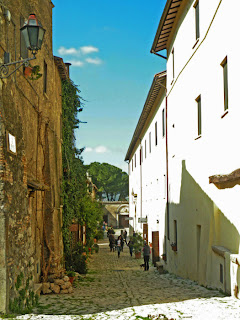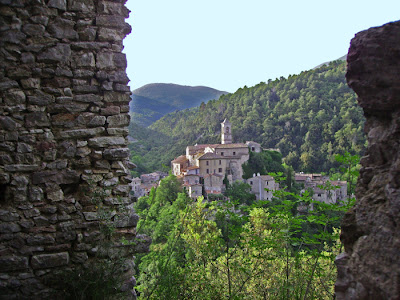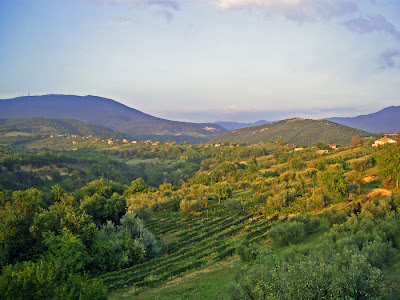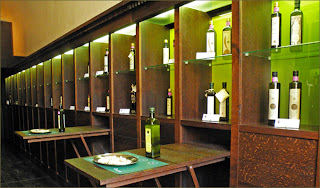Sabina is a little-known area of countryside in the Lazio region of Italy, around an hour’s drive north-east from Rome. It's a beautiful area of Lazio, with a culture all of its own. In this post, Emily from Visit Sabina introduces her little piece of paradise...
Introducing Sabina...

|
| A street in Farfa, Sabina |
Perhaps the most surprising thing about Sabina is just how close it is to Rome! It’s perfect for a day trip or short breaks from the city, and also ideal for longer breaks since it is easily reachable from both Ciampino and Fiumicino Airports.
There is no shortage of lovely places to visit on a trip here, so when Lazio Explorer asked if we could put together a little mini-guide to the Sabina region, we couldn’t resist! You can also check out our website for more information on Sabina in Italy.
Sabina, steeped in history
Travelling around Sabina is like taking a step back in time, with its medieval Borghi and Castelli. Sabina has its historical roots in 1000B.C, when the Sabini people first settled in the area. To Latin speakers, this area was known as Sabinium, and its inhabitants were known as Sabines.
Legend has it that the Roman Empire would never have existed if it weren’t for Romulus and the first Romans kidnapping and marrying some Sabine women to expand Rome’s population (see here for more details). After this episode, known as the Ratto delle sabine, the Sabines has no choice but to form one nation with the Romans and over time the Sabine culture became absorbed into Roman culture. Traces of it still remain today, and thanks to its past, Sabina itself is rich in sites of religious and historical interest.

|
| Rocchette as viewed from Rocchettine |
The archaeological Museum in Magliano Sabino houses artefacts from nearby excavations of ancient Sabina and its settlements. Sabina is also home to a number of castles, from ghostly ruins like Rocca de Antiquo in Roccantica to beautifully restored examples of medieval architecture, as with Castello Orsini in Nerola.
Of course, a must-see part of any visit to Sabina includes stops in some of the many beautiful medieval hilltop villages which dot the region. Roccantica, Casperia, Toffia and Tarano (see the photo at the start of this post) are some particularly charming examples.
The Landscape and nature
 The Sabina landscape ranges from the fertile plains and wetlands of the Tiber, to the lush, green hillsides and verdant valleys of the Monti Sabini, or Sabine hills, which form part of the Apennine mountain range. Sabina has been described as Italy’s answer to England’s Derbyshire. It even has a similar nickname: Sabinashire!
The Sabina landscape ranges from the fertile plains and wetlands of the Tiber, to the lush, green hillsides and verdant valleys of the Monti Sabini, or Sabine hills, which form part of the Apennine mountain range. Sabina has been described as Italy’s answer to England’s Derbyshire. It even has a similar nickname: Sabinashire! The beautiful views over the valleys and olive groves make it perfect for walking, cycling and even horse riding. Nature lovers will enjoy exploring the mountains, woods, rivers and wetlands of reserves such as the Riserva naturale di Nazzano, the Riserva naturale Monte Navegna e Monte Cervia and the Parco regionale naturale dei Monti Lucretili.
Sabina’s landscape means the area is full of wonderful flora and fauna, with beautiful wildflowers, herbs, and vegetables such as wild asparagus. Birdwatchers can spot various species including the hoopoe, bee-eater and even the golden eagle. Keep an eye out for porcupines, fireflies, lizards and wild boar (The latter can also often be seen on a plate mixed with some pappardelle).
The Food of Sabina
This brings us nicely onto the food in Sabina. Food here is, as is the case with much of Italy, a very important part of life. Agriculture forms an important part of the local economy, and therefore, culture.
The focus of the cooking is on the quality of the ingredients; fresh, seasonal and often sourced from local producers. There is a strong influence from Rome and cucina povera. The best way to sample some of the local cuisine is to stop for a long, relaxing lunch in an Agriturismo. You can also taste genuine local dishes by visiting one of the many Sagre (festivals) in Sabina, for example the Sagra delle fettucine in Scandriglia or the Sagra degli Stringozzi in Casperia, both of which take place in August. Typical types of pasta to try are strozzapreti, stringozzi, fettucine and maltagliata. Local cheeses include pecorino and ricotta. Mushrooms such as the porcino and galletto (chanterelle) varieties are collected from the surrounding mountains, and there are a number of dishes based on local lamb, rabbit, and offal like tripe and Coratella.
Sabina’s olive oil

|
| The Olioteca in Farfa |
The importance of the production of the olive oil for local culture is clear to see on a visit to the Sabina olive oil museum, with its collection of ancient olive presses. Then there is the Olioteca (olive oil shop) in Farfa, great for tastings of local oils made from different cultivars of olive. Sabina is also home to Europe’s biggest olive tree, located in the little village of Canneto. At two thousand years old, the trunk of this tree has a incredible circumference of around seven metres!
It’s difficult to sum Sabina up in a Blog post, but we hope this has given you an idea of what this area
has to offer! Read more about Sabina and all there is to discover at www.visitsabina.com.
Thanks for reading and we hope to see you in Sabina soon!

Sabina is really very nice and very similar to the umbrian countryside near Todi in my opinion. We have some friends in Poggio Mirteto: they have a "orto" in the Paradise Valley and their vegetables are heavenly! And think about it:last year my husband bought EVO from Poggio instead of our umbrian oil! He says it's nicer and not so spicy...mmmmm...not so agree ;)
ReplyDeleteThanks for your comment Elisa! I understand your husband, Sabine olive oil is wonderful! You can really taste the difference!
DeleteI was just thinking that Sabina looks like Umbria!
DeleteOne of the hidden treasures of Italy.
ReplyDeleteIt certainly is. Amazing considering it's so close to Rome.
DeleteBest olive oil on earth
ReplyDeleteWow Sabina! I love exploring Italy on the map, through various blogs and magazines until I visit it myself! Thanks for sharing Sabina with me:)
ReplyDeleteThanks Pete and Emily for sharing this information about Sabina. I am fortunate enough to have lived in this beautiful region for the past 8 years, in the medieval hilltop village of Toffia and have visited all the places you have mentioned in your article. It is great to see others writing about this area as it is such a hidden treasure, authentic and very much alive. Thanks for your article.
ReplyDeleteHi Sally, Thanks for your comment. I always find it amazing that so many people visit Rome and never explore the surrounding area. There's so much history, culture and local colour that people miss out on.
DeleteLazio region of Italy, around an hour’s drive north-east from Rome.travelling Moldova
ReplyDelete